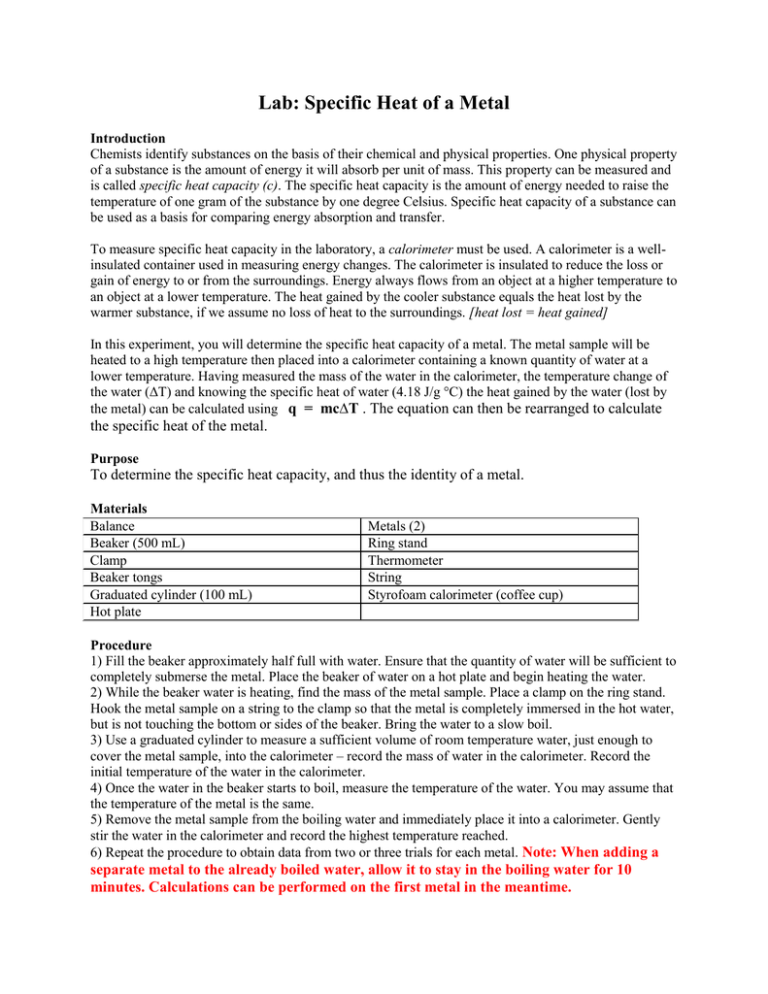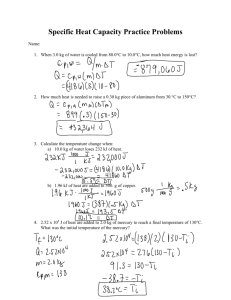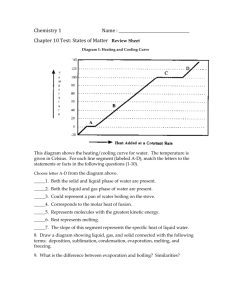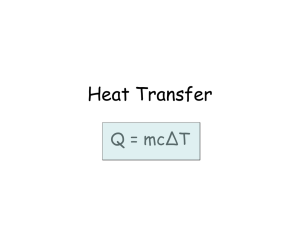specific heat of a metal lab
advertisement

Lab: Specific Heat of a Metal Introduction Chemists identify substances on the basis of their chemical and physical properties. One physical property of a substance is the amount of energy it will absorb per unit of mass. This property can be measured and is called specific heat capacity (c). The specific heat capacity is the amount of energy needed to raise the temperature of one gram of the substance by one degree Celsius. Specific heat capacity of a substance can be used as a basis for comparing energy absorption and transfer. To measure specific heat capacity in the laboratory, a calorimeter must be used. A calorimeter is a wellinsulated container used in measuring energy changes. The calorimeter is insulated to reduce the loss or gain of energy to or from the surroundings. Energy always flows from an object at a higher temperature to an object at a lower temperature. The heat gained by the cooler substance equals the heat lost by the warmer substance, if we assume no loss of heat to the surroundings. [heat lost = heat gained] In this experiment, you will determine the specific heat capacity of a metal. The metal sample will be heated to a high temperature then placed into a calorimeter containing a known quantity of water at a lower temperature. Having measured the mass of the water in the calorimeter, the temperature change of the water (ΔT) and knowing the specific heat of water (4.18 J/g °C) the heat gained by the water (lost by the metal) can be calculated using q = mc∆T . The equation can then be rearranged to calculate the specific heat of the metal. Purpose To determine the specific heat capacity, and thus the identity of a metal. Materials Balance Beaker (500 mL) Clamp Beaker tongs Graduated cylinder (100 mL) Hot plate Metals (2) Ring stand Thermometer String Styrofoam calorimeter (coffee cup) Procedure 1) Fill the beaker approximately half full with water. Ensure that the quantity of water will be sufficient to completely submerse the metal. Place the beaker of water on a hot plate and begin heating the water. 2) While the beaker water is heating, find the mass of the metal sample. Place a clamp on the ring stand. Hook the metal sample on a string to the clamp so that the metal is completely immersed in the hot water, but is not touching the bottom or sides of the beaker. Bring the water to a slow boil. 3) Use a graduated cylinder to measure a sufficient volume of room temperature water, just enough to cover the metal sample, into the calorimeter – record the mass of water in the calorimeter. Record the initial temperature of the water in the calorimeter. 4) Once the water in the beaker starts to boil, measure the temperature of the water. You may assume that the temperature of the metal is the same. 5) Remove the metal sample from the boiling water and immediately place it into a calorimeter. Gently stir the water in the calorimeter and record the highest temperature reached. 6) Repeat the procedure to obtain data from two or three trials for each metal. Note: When adding a separate metal to the already boiled water, allow it to stay in the boiling water for 10 minutes. Calculations can be performed on the first metal in the meantime. 7) Pour the water off the metal and dry it, then return it to the teacher. 8) Return all materials to where they belong. Ensure that your station is clean. Observations: Metal A Trial Mass of the metal (g) Initial temperature of the metal (boiling water) (oC) Mass of water in the calorimeter (1.00 g/mL) Initial temp. of water in in the calorimeter (oC) Final temperature of the metal and the water (oC) ∆T water (oC) ∆T metal (oC) 1 2 Metal B 1 2 Calculations (Show all work, using appropriate units) 1. For metal A, calculate: a) The heat gained by the water b) The heat lost by the metal c) The specific heat capacity of the metal 2. For metal B, calculate: a) The heat gained by the water b) The heat lost by the metal c) The specific heat capacity of the metal Questions 1. Identify your metals 2. Explain the sources of error in this lab 3. What physical properties, other than specific heat, could you use to help you identify the samples used in this experiment? 4. Propose a method for determining the specific heat of a metal like sodium that reacts with water. 5. Calculate the specific heat of a metallic element, if 314 joules of energy are needed to raise the temperature of a 50.0 g sample from 25.0 oC to 50.0 oC. Extension 1. According to the law of Dulong and Petit, the molar specific heats of most solid elements at room temperature are nearly constant. The molar specific heat can be estimated at 24.9 J/mol oC. a) Use the formula below to estimate the molar mass of each metallic sample. Molar mass = 24.9 J/mol oC specific heat capacity b) Does this information support or change your identification of your unknowns? Explain. 2. The British Thermal Unit of specific heat capacity (BTU) is still used by some engineers. The British Thermal Unit is defined as the amount of heat required to raise the temperature of one pound of a substance by one degree Fahrenheit. The specific heat capacity of water is 1.00 BTU. Calculate this value in Joules – in other words, calculate the energy required to raise the temperature of one pound of water by one degree Fahrenheit.







